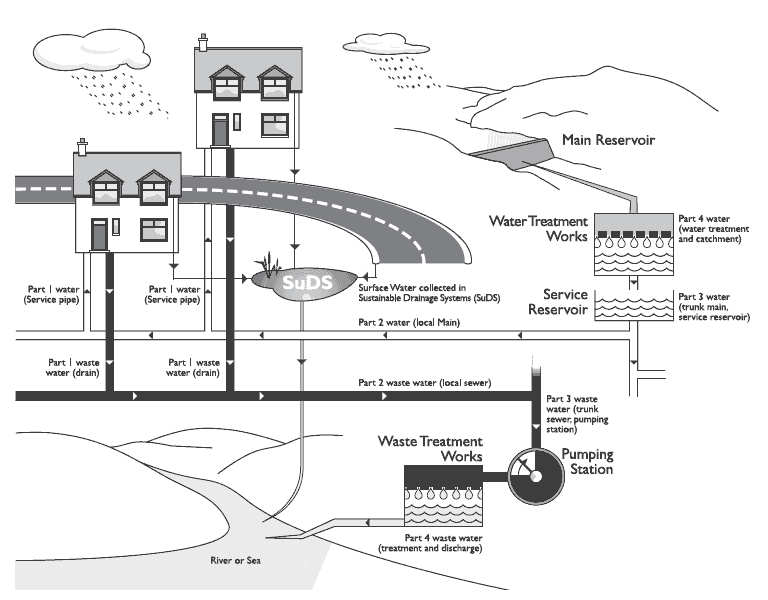Planning Advice Note 79: water and drainage
Planning Advice Note (PAN) 79 provides advice for planning authorities about setting the direction of development to inform the planning and delivery of new water infrastructure.
This document is part of a collection
HOW THE INFRASTRUCTURE WORKS
4. Water Supply - Water is taken from lochs, rivers, aquifers and reservoirs and piped to water treatment works. Harmful bacteria, plant material, minerals, natural or synthetic chemicals, and dirt are removed by screening (removal of debris), clarification (removal of mud and silt), filtration (removal of small grit and colour), disinfection (removal of bacteria) and pH correction (reduction of acidity). The treated water is stored in large tanks and service reservoirs. The clean water is then taken by trunk water mains and distributed to properties via local water mains and service pipes.
5. Waste Water - Waste water (sewage) from properties passes through the drains into the local waste water sewers and from there into the trunk waste water sewers to be directed to waste water treatment works. In the past the waste water network was used to capture both surface water runoff and foul water in one pipe. Since the 1950s the conventional approach to drainage has been to take the rainfall runoff from buildings, roads and pavements and directly discharge to a watercourse. For all new developments sustainable drainage schemes ( SuDS) are now required for surface water systems which provides attenuation and treatment prior to return, by natural dissipation where possible, to the water environment. Having separate systems frees capacity for waste water and reduces emergency overflows. Waste water is transported to treatment works where gross solids and grit are removed and the remaining water is treated. The organic solids which are removed from the water in the form of sludge are utilised in recycling outlets. Once the water is treated to an acceptable standard it can be discharged back to the river or the sea.
6. The water and drainage infrastructure described above can be split into four parts:
- Part 1 assets: connections from individual properties to a main or sewer;
- Part 2 assets: water mains and sewers that connect developments to trunk mains and trunk sewers, and some sustainable drainage systems ( SuDS);
- Part 3 assets: local bulk infrastructure, such as trunk mains and trunk sewers, water service reservoirs, waste water pumping stations and some SuDS; and
- Part 4 assets: strategic assets such as raw water intakes, raw water impounding reservoirs and aqueducts, water treatment works and waste water treatment works.
See the following diagram.
Diagram showing different parts of system

7. The great majority of assets under Parts 2, 3 and 4 are owned and maintained by Scottish Water, a public corporation set up by Scottish Ministers in 2002. There are also private systems, the maintenance of which is the responsibility of an owner or group of owners. Most small-scale private systems are septic tanks discharging to land soakaways or surface water, but they can also include systems providing a greater degree of treatment, such as SuDS, proprietary treatment systems or reedbeds. Private schemes can later be adopted by Scottish Water as part of their network, but only if built to an adoptable standard.
Contact
There is a problem
Thanks for your feedback